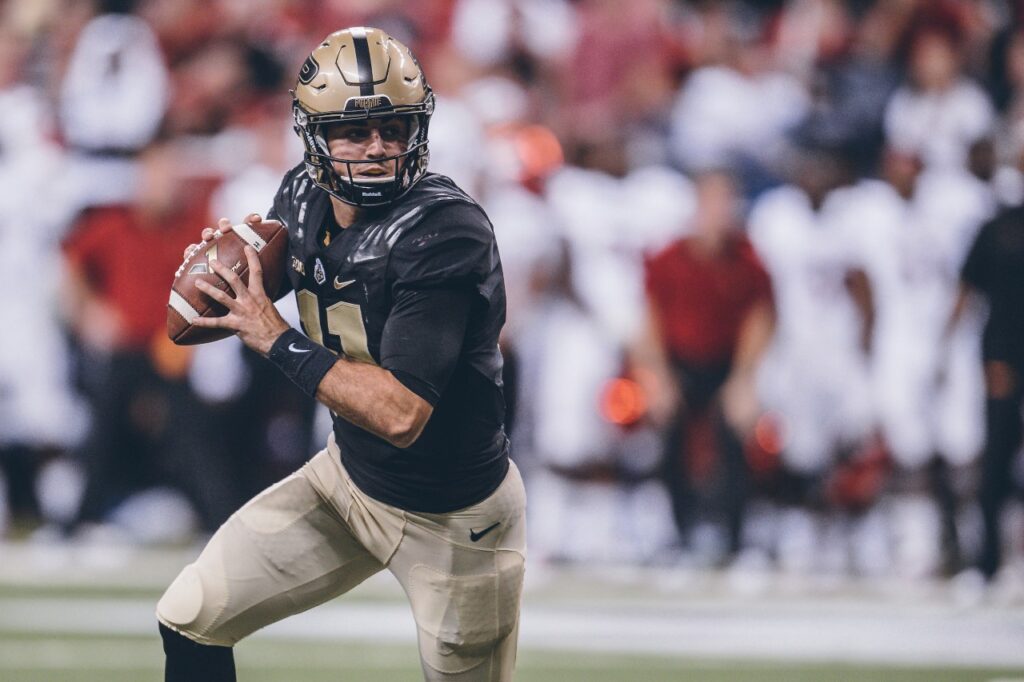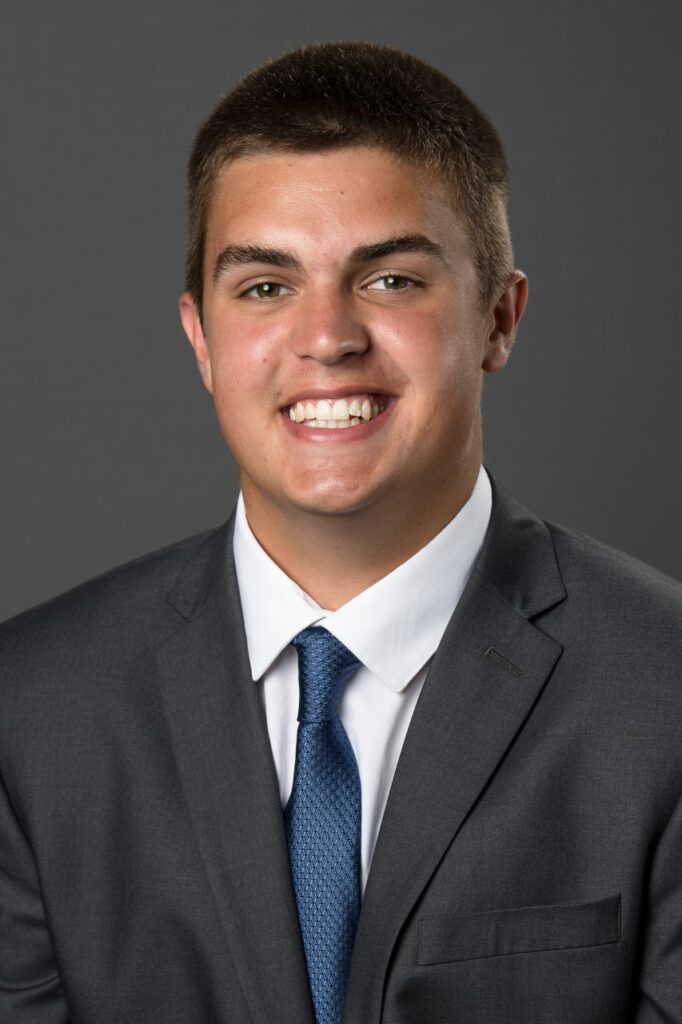Blog
Purdue U: the cradle of quarterbacks, pride of Indiana football

David Blough 
Aidan O’Connell 
Kenny Thompson
Even during the darkest times in Purdue football history (see: Hazell, Darrell. Also see: Akers, Fred), Boilermaker fans and administration could point with pride to the Cradle of Quarterbacks.
There’s even a section on the school’s athletic website (purduesports.com) devoted to the Cradle. Three members have been inducted into the College Football Hall of Fame (Bob Griese, Mike Phipps, Mark Herrmann). Len Dawson and Griese will be joined in the Pro Football Hall of Fame in a few years when Drew Brees becomes eligible.
Fifteen former Purdue quarterbacks have played in the NFL, throwing for more yards (248,731) and touchdown passes (1,642), as well as more starts (1,172), than any other school according to Elias Sports Bureau.
The last time Purdue declared the official membership of The Cradle was 2010, picking a dozen quarterbacks as part of a year-long celebration that included raising money for the 12th Boiler Scholarship Fund.
Before that official stamp of approval, membership in the Cradle of Quarterbacks was in the eye of the beholder.
In the early 1970s, university artist Keith Butz was commissioned to create a poster featuring Purdue’s outstanding quarterbacks of the past 30 years. That poster included Bob DeMoss, Dale Samuels, Dawson, Bernie Allen, Griese, Phipps and Gary Danielson.
Allen is better known to older Purdue fans as an outstanding baseball player. He played for Minnesota, the old Washington Senators, the New York Yankees and Montreal Expos in a career that spanned from 1962 to 1973.
Butz updated the poster, now titled “Cradle of Quarterbacks,” in the late 1970s to add Herrmann. A third update in the 1980s removed Allen and added Scott Campbell and Jim Everett.
Yet another poster, this time a collage of photos, came out in the late 1990s to add the late Eric Hunter, Billy Dicken and Brees, who was still playing for Purdue at the time.
For the 2010 poster, the 12 ranged chronologically from DeMoss (1945-48) to Curtis Painter (2005-08), and there was very little argument about the selections. All but Samuels (1950-52) had played in the NFL. Hunter and Dicken were not included in this updated poster.
Now 12 years later, it’s time to propose membership in the Cradle of Quarterbacks for two individuals.
The first candidate is David Blough, who overcame the odds of being an undrafted free agent to spending three seasons and making five NFL starts through 2021.
Discovered in Carrollton, Texas, by then-Purdue offensive coordinator John Shoop, Blough was part of the 2013 Elite 11 quarterbacks camp and nearly won its MVP honor.
At Purdue, Blough dueled for the starting job with Elijah Sindelar for most of his career. Winning the job in 2016, Blough threw for 3,352 yards and 25 touchdowns with 21 interceptions during the 3-9 season that spelled the end for Hazell in West Lafayette.
An ankle injury suffered against Illinois in 2017 ended Blough’s junior season prematurely. That likely contributed to Sindelar being chosen the starter by coach Jeff Brohm to start 2018.
That decision lasted the first half of the season opener because of a three interception performance against Northwestern. Blough took over for the rest of the season and threw for 3,521 yards and 25 touchdowns but with just eight interceptions.
Blough’s career passing yards (9,550) rank only behind Brees, Painter and Herrmann. His 69 TD passes rank third behind Brees (90) and Herrmann (71).
Even with a year and a half in Brohm’s passing offense, Blough’s numbers plus his NFL tenure are strong enough reasons for his addition into Purdue’s Cradle of Quarterbacks.
The next nominee has yet to write the final chapter in his Boilermaker career. One thing is certain, though: Aidan O’Connell’s rise from a walk-on to second-team All-Big Ten quarterback is a tale almost too unbelievable to be true.
O’Connell didn’t see the field until his third year on campus but he engineered two big comeback victories against Nebraska and at Northwestern in his first collegiate start. Against the Cornhuskers, O’Connell was 6 of 7 for 62 yards on the game-winning drive. The following week, a homecoming of sorts for the Long Grove, Ill., native, O’Connell was 34 of 50 passing for 271 yards and two touchdowns.
He also started at Wisconsin and against Indiana, combining for 697 yards and five touchdowns.
O’Connell won the starting job during the COVID-shortened 2020 season but only played three games due to injury. But those three games were a sign of things to come in 2021 as O’Connell was 88 of 136 passing for 916 yards and seven touchdowns.
In a replay of the Blough-Sindelar quarterback duel, O’Connell was beaten out by Jack Plummer to start the 2021 season. O’Connell did not play in the season-opening victory against Oregon State but threw two touchdown passes in the 49-0 victory at Connecticut in relief of Plummer.
The turning point for O’Connell, and arguably Purdue’s season, came in Game 4 against Illinois when he relieved an ineffective Plummer. Throwing for 89 yards during a 94-yard drive, O’Connell helped Purdue avoid an embarrassing home loss by throwing the game-winning touchdown pass to T.J. Sheffield with 5:14 remaining.
That effort established O’Connell as the starter and in no small way was responsible for Purdue going 6-3 the rest of the way with notable victories at No. 2 Iowa and against No. 3 Michigan State.
O’Connell’s 534-yard, four touchdown effort against Tennessee in the Music City Bowl capped a season that saw the fifth-year senior complete a school record 71.6 percent of his passes for 3,712 yards, 28 touchdowns and 11 interceptions.
With his decision to accept a sixth year of eligibility, O’Connell has a chance to move into Purdue’s all-time top five for passing yards and touchdown passes. He’s currently eighth in passing yards (5,729) and tied with Jim Everett for seventh in TD passes (43).
If the Big Ten can be comprised of 14 schools, why can’t Purdue’s Cradle of Quarterbacks expand to 14 as well?
In chronological order, here’s the current roster of Purdue’s Cradle of Quarterbacks:
- Bob DeMoss (1945-48)
- Dale Samuels (1950-52)
- Len Dawson (1954-56)
- Bob Griese (1964-66)
- Mike Phipps (1967-69)
- Gary Danielson (1970-72)
- Mark Herrmann (1977-80)
- Scott Campbell (1980-83)
- Jim Everett (1981-85)
- Drew Brees (1997-2000)
- Kyle Orton (2001-04)
- Curtis Painter (2005-08)
Noteworthy
Staying on the subject of quarterbacks, O’Connell is ranked the Big Ten’s No. 2 quarterback entering the 2022 season by Alex Hickey of Saturday Tradition.
It’s no surprise that No. 1 is Ohio State’s C.J. Stroud, the reigning first-team All-Big Ten quarterback.
“O’Connell is … the Big Ten’s second-best quarterback by a comfortable margin,” Hickey writes. “… He looks ready for an excellent senior season. If he cuts down on the 11 interceptions, the Boilermakers can compete for the Big Ten West title.”
Coming in at No. 7 is presumed Indiana starter Connor Bazelak, a transfer from Missouri.
“The Missouri transfer brings much-needed credibility to Indiana’s quarterback room after things unraveled in 2021,” Hickey writes. “Bazelak was fifth in the SEC with 231.6 yards per game, though he did it at a very dink-and-dunk rate of 6.8 yards per completion. Bazelak’s ratio of 16 touchdowns and 11 interceptions will need to improve in the Big Ten. …
The 2021 NFL season is still going on but for a couple of national media outlets, it’s never too early to look at the 2022 Draft.
The first mock draft by ESPN’s longtime analyst Mel Kiper Jr. predicts former Purdue standout George Karlaftis being chosen by Arizona with the 23rd selection.
“J.J. Watt is still signed for another season, but his injury history means that Arizona needs to think about a replacement,” Kiper writes. “That’s Karlaftis, a powerful 275-pound end who might be better in a 3-4 defense. He had only 4.5 sacks in 2021 but his pressure numbers were elite, even if he didn’t always get home to the quarterback. He’s really good against the run, too.”
The Athletic’s Dane Brugler has Karlaftis headed to Philadelphia with the 19th pick.
“The Eagles’ defensive end depth chart will likely look wildly different next season, and Karlaftis would be a welcomed addition,” Brugler writes. “The Purdue pass rusher doesn’t have elite length or twitch, but he is relentless and strong with hand work that is not only violent but also well-timed and strategic to defeat blockers.
Unlike Kiper, Brugler extended his draft forecast to the second round, where he has All-American wide receiver David Bell going to Atlanta with the 63rd pick Kenny Thompson is the former sports editor for the Lafayette Journal & Courier and an award-winning journalist. He has covered Purdue athletics for many years.
